| View previous topic :: View next topic |
| Author |
Message |
cooltouch


Joined: 15 Jan 2009
Posts: 9096
Location: Houston, Texas
|
 Posted: Wed Apr 29, 2015 2:26 pm Post subject: 17mm lens comparison: Tamron vs Vivitar (by Tokina) Posted: Wed Apr 29, 2015 2:26 pm Post subject: 17mm lens comparison: Tamron vs Vivitar (by Tokina) |
 |
|
cooltouch wrote:
Alright, I've been trying to get a valid comparison done for these two lenses for some time now, and for reasons that I'm still not clear on, yesterday I managed to finally get some decent shots with both lenses. Viewinng wasn't the best; it was cloudy and overcast, but there was sufficient light for me to get the comparison done. I'll add to the photos as weather permits, but for now I have only two sets to compare.
As most of you here know, the Vivitar 17mm is a lens that was built by Tokina and is supposed to be the optical equivalent of the famed Tokina 17mm, the most notable difference between the two being the coatings. Suppsedly the Tokina has the superior coatings. There is also a slight physical difference between the two as well. The Vivitar has a built-in petal-style hood, whereas the Tokina does not.
As for the Tamron, I have read that it is slightly inferior to the Tokina in terms of IQ. That claim doesn't hold up in this comparison, however.
Finally, there is a difference in the way these two lenses behave. The Vivitar behaves the way you would expect an ultra-wide angle to behave. That is, turning the focusing collar doesn't make a whole lot of difference to the scene because of the lens's outstanding depth of field. Whereas the Tamron behaves much more like a lens closer to a standard focal length. Even though its depth of field is essentially the same as the Vivitar, it does not behave as if it is. There's a noticeable difference in focus points when the focusing collar is turned.
OK, the first set of photos is of an old fence gate, chosen because of its texture. First we have photos of the gate, reduced for viewing here. Then we have crops of the gate's center, and finally crops of the top left corner of the field of view. Shots were taken using my NEX 7, ISO was set to "Auto," although amost all images were shot at ISO 100.
Tamron 17mm f/3.5 @ f/8

Vivitar 17mm f/3.5 @ f/8
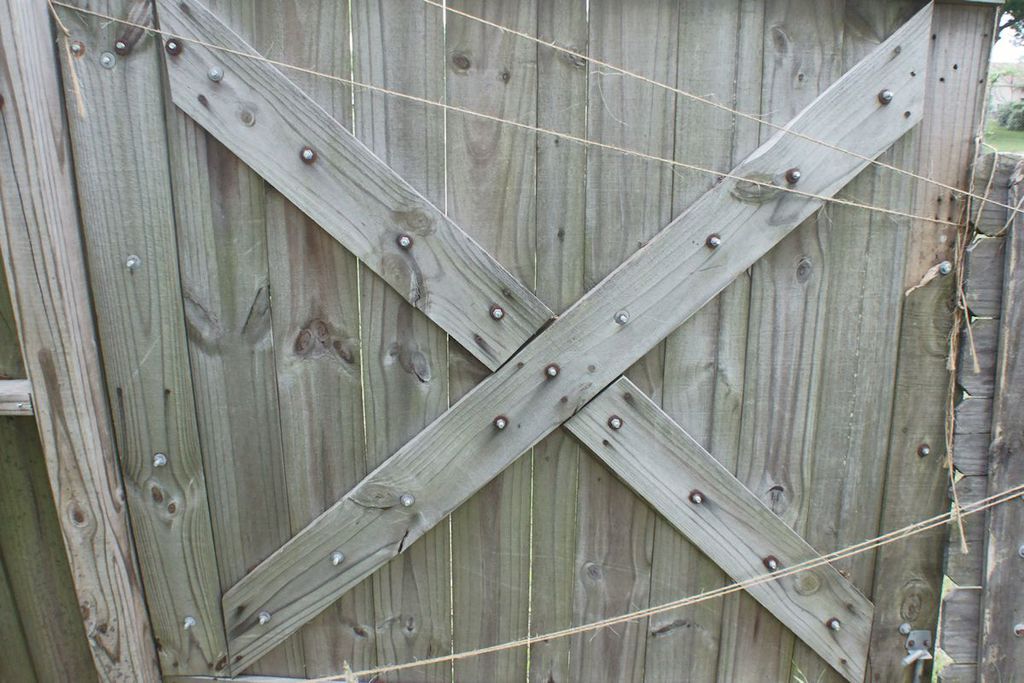
Tamron 17mm f/3.5 @ f/8 -- center of the fence gate, 100% crop
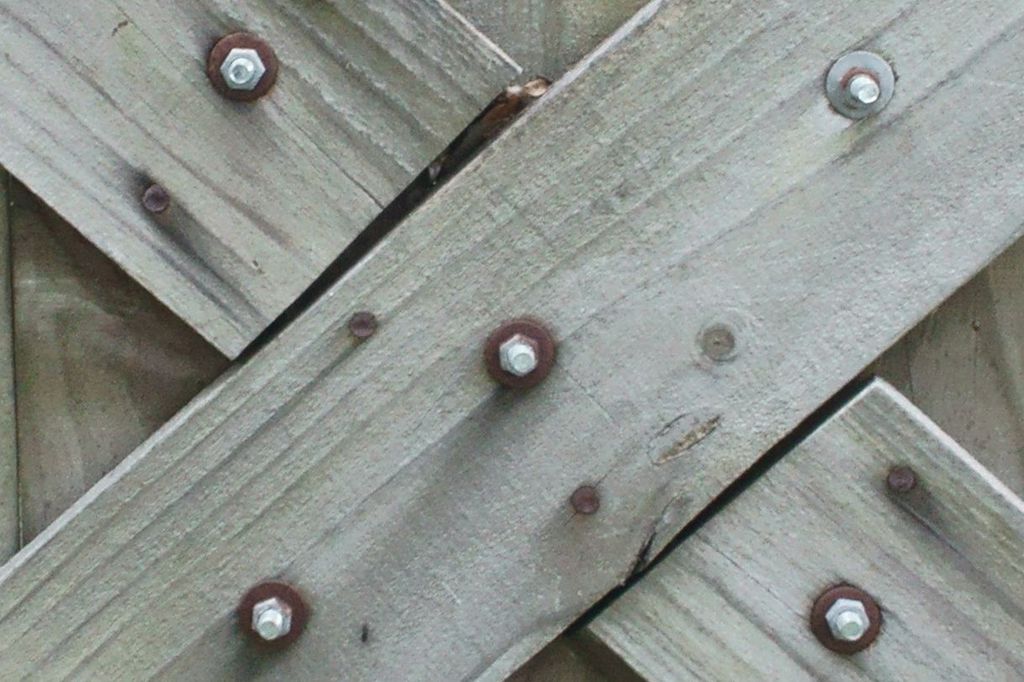
Vivitar 17mm f/3.5 @ f/8 -- center of the fence gate, 100% crop
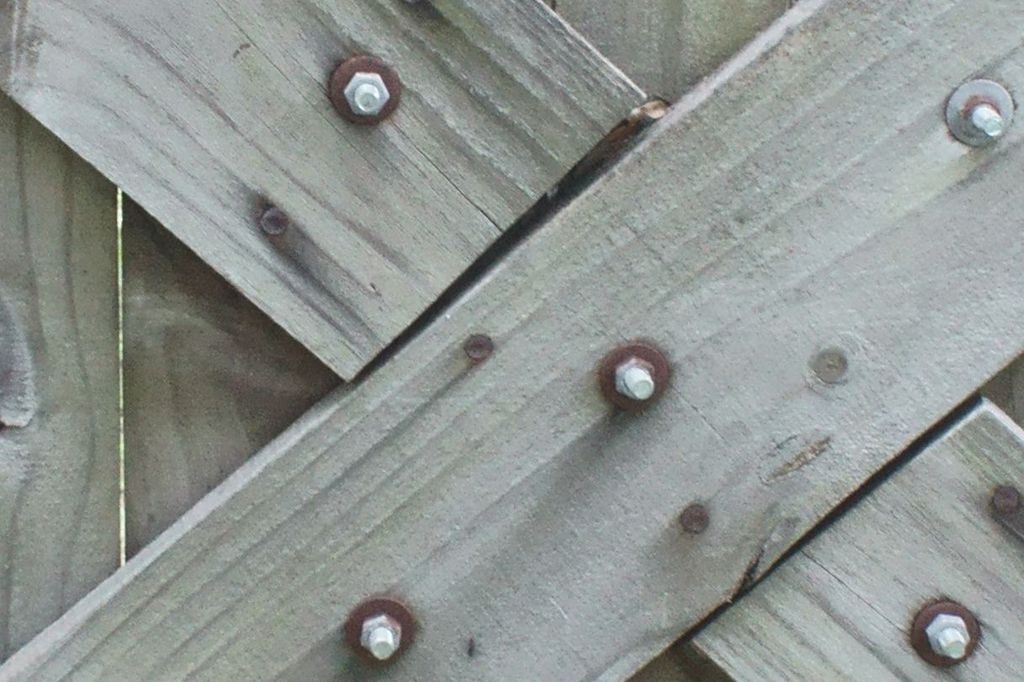
Tamron 17mm f/3.5 @ f/8 -- top left corner of the fence gate, 100% crop

Vivitar 17mm f/3.5 @ f/8 -- top left corner of the fence gate, 100% crop

Tamron 17mm f/3.5 @ f/8 Day Lily
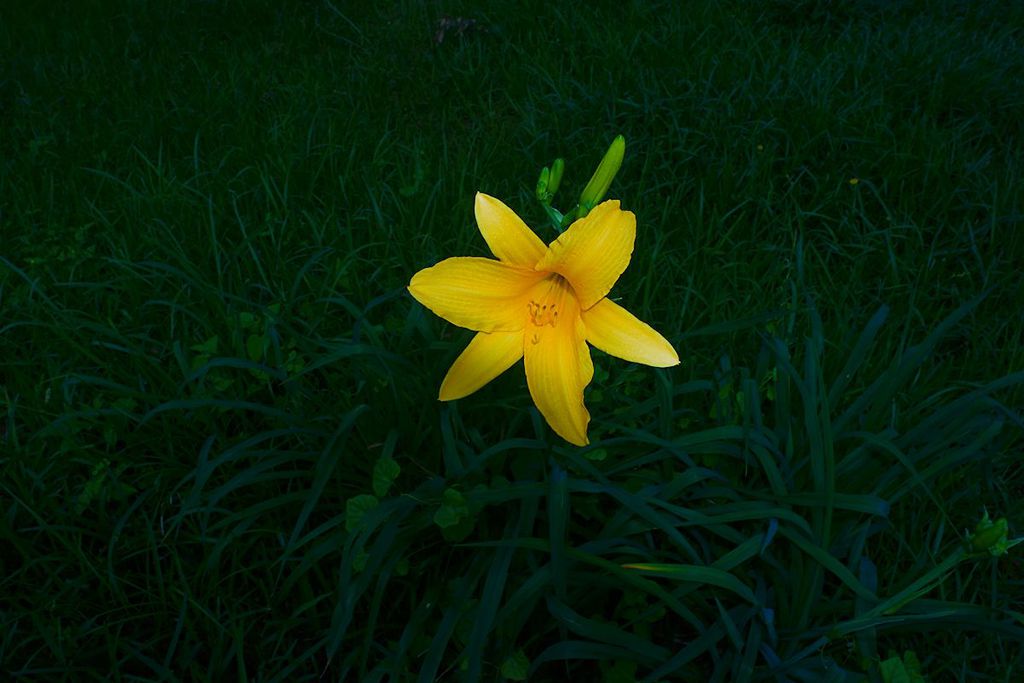
Vivitar 17mm f/3.5 @ f/8 Day Lily
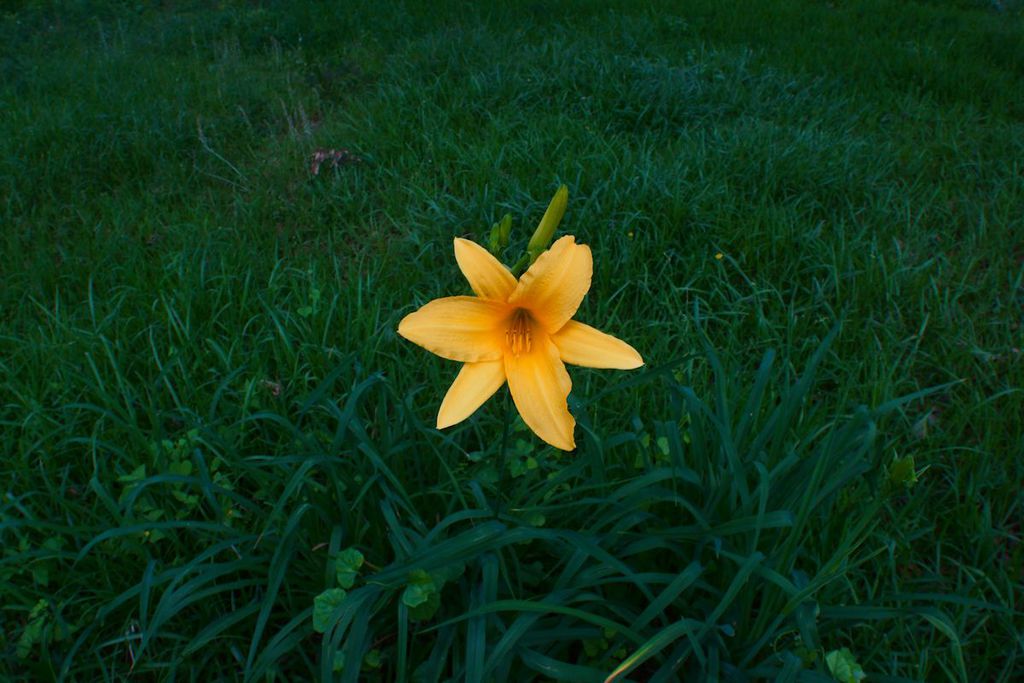
Tamron 17mm f/3.5 @ f/8 Day Lily Center, 100% crop

Vivitar 17mm f/3.5 @ f/8 Day Lily Center, 100% crop

So, which lens gives the sharpest, contrastiest image? What's your choice? To me, the Tamron shows the slightest edge over the Vivitar, but I'm having to peep pixels to see the difference. At first, I though the Tamron showed an advantage on the corner. But now that I've been able to compare the results, I don't see much difference at all.
I'll add images to this thread as the opportunity presents itself. Today, for the first day this week, it's a mild sunny day, so I plan to get out there and take some more shots.
_________________
Michael
My Gear List: http://michaelmcbroom.com/photo/gear.html
My Gallery: http://michaelmcbroom.com/gallery3/index.php/
My Flickr Page: https://www.flickr.com/photos/11308754@N08/albums
My Music: https://soundcloud.com/michaelmcbroom/albums
My Blog: http://michaelmcbroom.com/blogistan/ |
|
| Back to top |
|
 |
ManualFocus-G


Joined: 29 Dec 2008
Posts: 6622
Location: United Kingdom
Expire: 2014-11-24
|
 Posted: Wed Apr 29, 2015 7:19 pm Post subject: Posted: Wed Apr 29, 2015 7:19 pm Post subject: |
 |
|
ManualFocus-G wrote:
Interesting. I tested the second version of the Tamron SP 17/3.5 against the Soligor 17/3.5 (same Tokina lens) on ff and found the Tamron to be sharper throughout and with more contrast.
For some reason I preferred the look of the Soligor lens though (the look of the lens not the images produced  ) ) |
|
| Back to top |
|
 |
Phenix jc


Joined: 19 Dec 2009
Posts: 398
Location: France
|
 Posted: Wed Apr 29, 2015 8:27 pm Post subject: Posted: Wed Apr 29, 2015 8:27 pm Post subject: |
 |
|
Phenix jc wrote:
Thank you!
I expected this kind of direct comparison for long!
Same level for me.
An architectural shot just to have a look at the distortion, and I would go on the Tokina which (was and) is much, much cheaper (and that I have inherited from the film era actually)
_________________
"Plonger les choses dans la lumière, c'est les plonger dans l'infini" Léonard De Vinci
f/1.2 club Zuiko : 50/1.2, 55/1.2 Rokkor : 50/1.2, 58/1.2 Nikkor : 50/1.2, 55/1.2 Third Party : Porst(Fujinon-X) 50/1.2, Porst 55/1.2 Canon : S 50/1.2, nFD 50/1.2, FL 55/1.2, R 58/1.2, nFD 85/1.2 Hexanon : 57/1.2 Nokton : 50/1.1 |
|
| Back to top |
|
 |
Lloydy


Joined: 02 Sep 2009
Posts: 7787
Location: Ironbridge. UK.
Expire: 2022-01-01
|
 Posted: Wed Apr 29, 2015 10:12 pm Post subject: Posted: Wed Apr 29, 2015 10:12 pm Post subject: |
 |
|
Lloydy wrote:
The flower shots at f8 - the Tamron is way underexposed for the backgroung, the Vivitar / Tokina is slightly overexposed but 'what people would expect' - there's background. The distance the shots were taken is very slightly different, is that enough to make that much difference ? And, would that slight distance difference difference make a difference to the crops?
As far as sharpness goes, the difference is so slight it's hardly worth getting excited about, but if the Vivitar / Tokina pulls in more light at f8 ( in theory surely they should be the same ? ) then that would be the deal breaker for me.
I have the Tokina and love it. I am also a huge fan of Tamron's, so I would own either at the drop of a hat. Especially after having tried the Sigma 16 which I hated.
_________________
LENSES & CAMERAS FOR SALE.....
I have loads of stuff that I have to get rid of, if you see me commenting about something I have got and you want one, ask me.
My Flickr https://www.flickr.com/photos/mudplugga/
My ipernity -
http://www.ipernity.com/home/294337 |
|
| Back to top |
|
 |
cooltouch


Joined: 15 Jan 2009
Posts: 9096
Location: Houston, Texas
|
 Posted: Thu Apr 30, 2015 5:32 am Post subject: Posted: Thu Apr 30, 2015 5:32 am Post subject: |
 |
|
cooltouch wrote:
I wouldn't be drawing too many conclusions about the difference in light levels between the two lenses. I was dealing with failing light, so that might have been it. I went back and looked at the raw images -- they're about the same. I probably bumped up the Vivitar's EV when I was converting the image from raw to jpg.
I actually went back in the house to get the Vivitar and shoot the same subjects. I probably chose a slightly different spot, but I tried to be as close as possible.
MFG: this is also the second version. No built-in filters. Adaptall-2.org doesn't say specifically, but I'm assuming they both share the same optical design. I do know the first version is more desirable because of the built-in filters, though. I would have preferred it, but I couldn't complain about the price I got this one for, especially since it had the hood.
You know, these two lenses have been giving me fits trying to get good sharp shots with them. Inevitably they end up being too blurry for my tastes. And I finally figured out what the deal is. They work fine when I'm taking pics of close-up subjects. But if I try to do a landscape shot -- of items even as far away as a few tens of meters -- everything changes. Even if I focus precisely on a specific spot, maybe that spot will be in focus in the image, but beyond that depth, everything gets soft. But wide angle lenses aren't supposed to behave that way, especially when I've been using a hyperfocal setting. And the reason why this is happening isn't because there's something wrong with the lenses. It's my camera -- the NEX 7. With its APS-C sensor, it just can't handle the way these analog wides bend light. That's the only thing I can think of. And to prove my point to myself, I mounted the NEX's kit lens -- an 18-55. I set it to 18mm and shot the same subjects. What a difference. With the lens set to 18mm, the photos were nice and clear. So that's it then. The following shots will show clearly what I'm getting at. They are 100% crops of a tree in my back yard. I was standing probably 25-30 meters from it when I took the shots.
Tamron 17mm
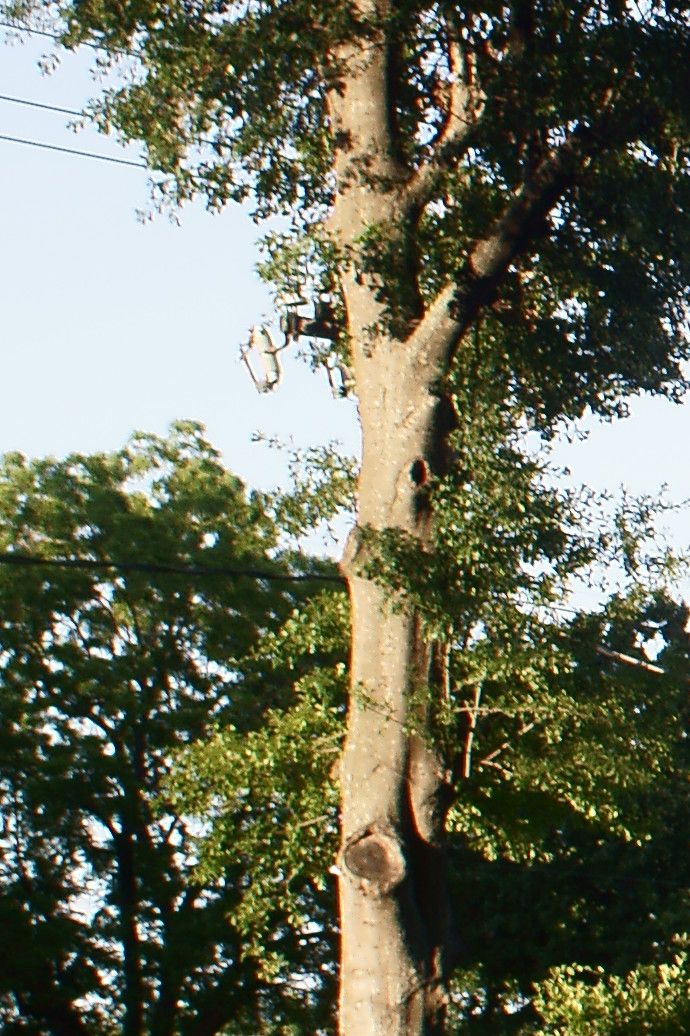
Vivitar 17mm
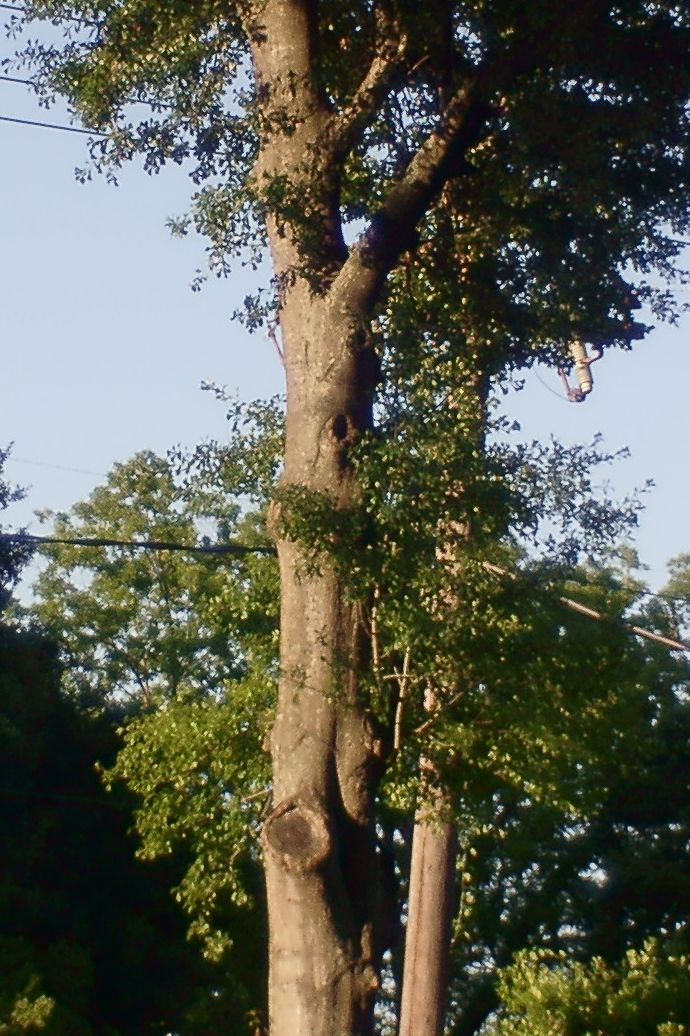
Sony 18-55mm @ 18mm

All the above shots were taken at ISO 100, and all three lenses were set to f/8.
I think tomorrow I'll give the Tamron a try on my APS-C Canon XS. It has only a 10.1mp sensor, so maybe it won't behave as badly as the NEX. I'll try the Tamron with it, since the Vivitar is a Canon FD mount, which won't work optimally on the EOS.
Meanwhile, I'm still running an evaluation test with both these lenses, but I'm doing it with a pair of film cameras, one Canon FD and one Nikon (I have an adaptall-2 Nikon mount on the Tamron). I suspect that the results I get with these two film cameras will be much better than the results I was getting with the NEX.
In case you're wondering why I'm going to all this trouble with this pair of lenses, it's because I want to find out just how good the Vivitar is, basically. The Tamron, being an adaptall-2 lens, allows me to mount it to most any camera, but because the Vivitar has a Canon FD mount, I can't mount it to most digital cameras except for a mirrorless. One of these days I'm gonna buy a full-frame mirrorless camera and when that day comes I suspect both these lenses will perform much better than they are with my NEX 7. But when that day comes, obviously I won't need both 17mm's. Which means I'll be able to sell one -- most likely the Vivitar. But if the Vivitar should outperform the Tamron, then I won't want to sell it. I was hoping I could make this determination with my NEX, but obviously I can't.
Oh well. Just be patient, I tell myself. I might come into a good chunk of money later this year, which will allow me to pick up a FF mirrorless. And hopefully Sony will have come out with a nexgen version of the A7x by then.
_________________
Michael
My Gear List: http://michaelmcbroom.com/photo/gear.html
My Gallery: http://michaelmcbroom.com/gallery3/index.php/
My Flickr Page: https://www.flickr.com/photos/11308754@N08/albums
My Music: https://soundcloud.com/michaelmcbroom/albums
My Blog: http://michaelmcbroom.com/blogistan/ |
|
| Back to top |
|
 |
Lloydy


Joined: 02 Sep 2009
Posts: 7787
Location: Ironbridge. UK.
Expire: 2022-01-01
|
 Posted: Thu Apr 30, 2015 8:31 am Post subject: Posted: Thu Apr 30, 2015 8:31 am Post subject: |
 |
|
Lloydy wrote:
I find that the Tokina 17 on my Sony A6000 is lens that I have to be careful with, a lot of pictures I take aren't as sharp as they look initially when chimping on the camera. Pictures taken quickly at a hyperfocal setting are the worst. I'm finding that I have to open the lens up, focus carefully, then close down if I want more DoF. Which is counter-intuitive to normal use of a lens this wide.
It's easy to think we can point and shoot with these lenses, but I think your explanation is right and we can't.
_________________
LENSES & CAMERAS FOR SALE.....
I have loads of stuff that I have to get rid of, if you see me commenting about something I have got and you want one, ask me.
My Flickr https://www.flickr.com/photos/mudplugga/
My ipernity -
http://www.ipernity.com/home/294337 |
|
| Back to top |
|
 |
cooltouch


Joined: 15 Jan 2009
Posts: 9096
Location: Houston, Texas
|
 Posted: Fri May 01, 2015 4:23 am Post subject: Posted: Fri May 01, 2015 4:23 am Post subject: |
 |
|
cooltouch wrote:
It sounds like your experiences pretty much agree exactly with mine, Llloyd. I've never had a WA lens before where I couldn't trust hyperfocal settings to work. The Tamron doesn't even behave like a wide, more like a normal, the way it focuses. Whereas the Vivitar behaves much more like a wide. But its hyperfocal settings can't be trusted either with my NEX.
Well, today, I mounted the Tamron 17 to my Canon EOS XS (10.1mp). I was reasoning that a 10.1mp sensor may have sensor elements that are not as closely packed as they are on my NEX, and that perhaps it wouldn't react so oddly to this lens's images. Well, no luck. It was just as bad with my EOS. Even using Live View, I could get the focus reasonably accurate on a subject, but forget about the hyperfocal distances -- they just weren't there.
So, at this point I'm very curious how a wide, like the Tamron or the Tokina (or the Tokina-made Vivitar) behaves with an FF camera like a Sony A7 or A7r or A7s, or whatever. I suspect that it will behave normally, but then there's that side of me that is distrustful now, so I would like to see proof.
_________________
Michael
My Gear List: http://michaelmcbroom.com/photo/gear.html
My Gallery: http://michaelmcbroom.com/gallery3/index.php/
My Flickr Page: https://www.flickr.com/photos/11308754@N08/albums
My Music: https://soundcloud.com/michaelmcbroom/albums
My Blog: http://michaelmcbroom.com/blogistan/ |
|
| Back to top |
|
 |
ManualFocus-G


Joined: 29 Dec 2008
Posts: 6622
Location: United Kingdom
Expire: 2014-11-24
|
 Posted: Fri May 01, 2015 7:54 am Post subject: Posted: Fri May 01, 2015 7:54 am Post subject: |
 |
|
ManualFocus-G wrote:
Are those trees from the centre of the frame? The 17mms have all sorts of field curvature and distortion  I'll try to dig some ff shots out later, although I think modern lenses have improved ultra-wide angle work significantly. I'll try to dig some ff shots out later, although I think modern lenses have improved ultra-wide angle work significantly.
_________________
Graham - Moderator 
Shooter of choice: Fujifilm X-T20 with M42, PB and C/Y lenses
See my Flickr photos at http://www.flickr.com/photos/manualfocus-g |
|
| Back to top |
|
 |
cooltouch


Joined: 15 Jan 2009
Posts: 9096
Location: Houston, Texas
|
 Posted: Fri May 01, 2015 8:22 am Post subject: Posted: Fri May 01, 2015 8:22 am Post subject: |
 |
|
cooltouch wrote:
Yes the trees are from the center of the frame, or very close to it. Otherwise you probably would see some curvature.
I've known about the Vivitar's barrel distortion for many years. Shortly after I bought it, I lay down in the center of the floor of my father's study and took a picture of the ceiling. His office was a cool place with some rather ornate crown molding and other stuff on the ceiling, the particulars of which I don't recall anymore. Anyway, the picture clearly illustrated the curvature along the edges of the frame of the photo. But I didn't care all that much because I used the lens mostly for scenics and landscapes. I have one photo up at my website that somewhat illustrates the curvature it causes:

The power pole on the right is largely unaffected, but its farther away from the edge of the frame. The stop sign post is closer to the edge and does show some curvature, but it's not that bad, really.
As for the Tamron, I haven't yet had the opportunity to take any photos that would illustrate its distortion.
_________________
Michael
My Gear List: http://michaelmcbroom.com/photo/gear.html
My Gallery: http://michaelmcbroom.com/gallery3/index.php/
My Flickr Page: https://www.flickr.com/photos/11308754@N08/albums
My Music: https://soundcloud.com/michaelmcbroom/albums
My Blog: http://michaelmcbroom.com/blogistan/ |
|
| Back to top |
|
 |
Basilisk

Joined: 21 Mar 2013
Posts: 356
Location: UK
|
 Posted: Mon May 04, 2015 10:16 am Post subject: Posted: Mon May 04, 2015 10:16 am Post subject: |
 |
|
Basilisk wrote:
| Lloydy wrote: |
I find that the Tokina 17 on my Sony A6000 is lens that I have to be careful with, a lot of pictures I take aren't as sharp as they look initially when chimping on the camera. Pictures taken quickly at a hyperfocal setting are the worst. I'm finding that I have to open the lens up, focus carefully, then close down if I want more DoF. Which is counter-intuitive to normal use of a lens this wide.
It's easy to think we can point and shoot with these lenses, but I think your explanation is right and we can't. |
My Tokina RMC version has the same problem. Maybe the focus scale is mis-adjusted, I find I have to go near infinity to get things in focus that are not that far away. It is sharp when done right, but the OVF on my Nikon D600 is not great for precision focus of slowish superwides.
If it had a better minimum focus distance, I might use it a lot more. Don't get a lot of background blur with this lens even at 0.5m with f3.5. |
|
| Back to top |
|
 |
Basilisk

Joined: 21 Mar 2013
Posts: 356
Location: UK
|
 Posted: Mon May 04, 2015 10:22 am Post subject: Posted: Mon May 04, 2015 10:22 am Post subject: |
 |
|
Basilisk wrote:
I have to say, on a crop frame, I would probably stick with the wide end of the kit zoom, rather than finding a MF prime at this length. Without spending a lot of money, the advantages of a prime are not going to be that great in terms of speed or image quality. Unlike the normal to telephoto end where a nice prime gives real creative advantages.
On full frame, though, a decent 17mm gives me a much wider view than the 24mm on my kit zoom. |
|
| Back to top |
|
 |
cooltouch


Joined: 15 Jan 2009
Posts: 9096
Location: Houston, Texas
|
 Posted: Mon May 04, 2015 4:29 pm Post subject: Posted: Mon May 04, 2015 4:29 pm Post subject: |
 |
|
cooltouch wrote:
Well, yeah, if you're talking about a 24mm used on your full-frame camera. But I agree with you about using a kit zoom on the NEX. Only problem is, for me, it isn't wide enough. 18mm equates to a 35mm equivalent of 27mm on my NEX. I'd want to have at least a 24mm equivalent setting on the zoom. Makes me wonder about the 16-50 kit zoom that comes with the a6000, though. That is, I wonder about its quality because it seems to be quite cheap, price-wise. 16mm is the equivalent of 24mm, which I find much more useful.
For really wide stuff with my NEX, I'd love to have the 10-18mm Sony lens, but it costs more than I paid for my NEX 7 kit with spare battery even. And apparently none of the big three aftermarket makers produce an ultra-wide zoom for the NEX -- yet.
An alternative would be to buy a Lens Turbo or Metabones focal reducer for the NEX. But now that I'm so gunshy about those ultra wides, I wonder if their performance would be worth the cost of the reducer.
_________________
Michael
My Gear List: http://michaelmcbroom.com/photo/gear.html
My Gallery: http://michaelmcbroom.com/gallery3/index.php/
My Flickr Page: https://www.flickr.com/photos/11308754@N08/albums
My Music: https://soundcloud.com/michaelmcbroom/albums
My Blog: http://michaelmcbroom.com/blogistan/ |
|
| Back to top |
|
 |
barryreid


Joined: 27 Aug 2013
Posts: 285
Location: London
Expire: 2015-11-04
|
 Posted: Mon May 04, 2015 6:58 pm Post subject: Posted: Mon May 04, 2015 6:58 pm Post subject: |
 |
|
barryreid wrote:
I had that 16-50 on my NEX-6 and TBH found it, before software correction does it's thing, to be the worst lens I've ever used, distortion and big netting on an epic scale. That said it made extraordinarily handy package with the NEX and I would consider owning that pairing (or an A6000) again if money was no object.
_________________
Canon + Contax + Minolta + Nikon + Olympus + Pentax + Yashica = Adaptall-2 |
|
| Back to top |
|
 |
Basilisk

Joined: 21 Mar 2013
Posts: 356
Location: UK
|
 Posted: Mon May 04, 2015 7:18 pm Post subject: Posted: Mon May 04, 2015 7:18 pm Post subject: |
 |
|
Basilisk wrote:
| cooltouch wrote: |
Well, yeah, if you're talking about a 24mm used on your full-frame camera. But I agree with you about using a kit zoom on the NEX. Only problem is, for me, it isn't wide enough. 18mm equates to a 35mm equivalent of 27mm on my NEX. I'd want to have at least a 24mm equivalent setting on the zoom. Makes me wonder about the 16-50 kit zoom that comes with the a6000, though. That is, I wonder about its quality because it seems to be quite cheap, price-wise. 16mm is the equivalent of 24mm, which I find much more useful.
For really wide stuff with my NEX, I'd love to have the 10-18mm Sony lens, but it costs more than I paid for my NEX 7 kit with spare battery even. And apparently none of the big three aftermarket makers produce an ultra-wide zoom for the NEX -- yet.
An alternative would be to buy a Lens Turbo or Metabones focal reducer for the NEX. But now that I'm so gunshy about those ultra wides, I wonder if their performance would be worth the cost of the reducer. |
Mirrorless gives you the option of a focal reducer, which might be worth trying. On a Canon DSLR you can't do that. |
|
| Back to top |
|
 |
tb_a


Joined: 26 Jan 2010
Posts: 3678
Location: Austria
Expire: 2019-08-28
|
 Posted: Mon May 04, 2015 7:25 pm Post subject: Posted: Mon May 04, 2015 7:25 pm Post subject: |
 |
|
tb_a wrote:
| cooltouch wrote: |
For really wide stuff with my NEX, I'd love to have the 10-18mm Sony lens, but it costs more than I paid for my NEX 7 kit with spare battery even. And apparently none of the big three aftermarket makers produce an ultra-wide zoom for the NEX -- yet.
|
Have you ever considered one of the two ultra wide Voigtlaenders in 12 or 15mm?
They are used not so extreme expensive and possible problems on the NEX 7 could be corrected in PP.
I love those lenses and I'm happy that they work very good on my Ricoh GXR without any problems.
_________________
Thomas Bernardy
Manual focus lenses mainly from Minolta, Pentax, Voigtlaender, Leitz, Topcon and from Russia (too many to be listed here). |
|
| Back to top |
|
 |
Lloydy


Joined: 02 Sep 2009
Posts: 7787
Location: Ironbridge. UK.
Expire: 2022-01-01
|
 Posted: Mon May 04, 2015 8:16 pm Post subject: Posted: Mon May 04, 2015 8:16 pm Post subject: |
 |
|
Lloydy wrote:
When I bought my A6000, replacing my NEX5, it was just before a long vacation in the USA. I took some manual lenses but mainly used the 16-50 OSS lens, which I have to say did the job perfectly. Is it a good lens in comparison to the old manual lenses I generally use? It's probably better than a lot of lenses I have. I processed very few of my USA pictures, distortion wasn't an issue for me. But at the wide end the ease of use and the results I got make it the sensible choice. But I still use my Tokina. 
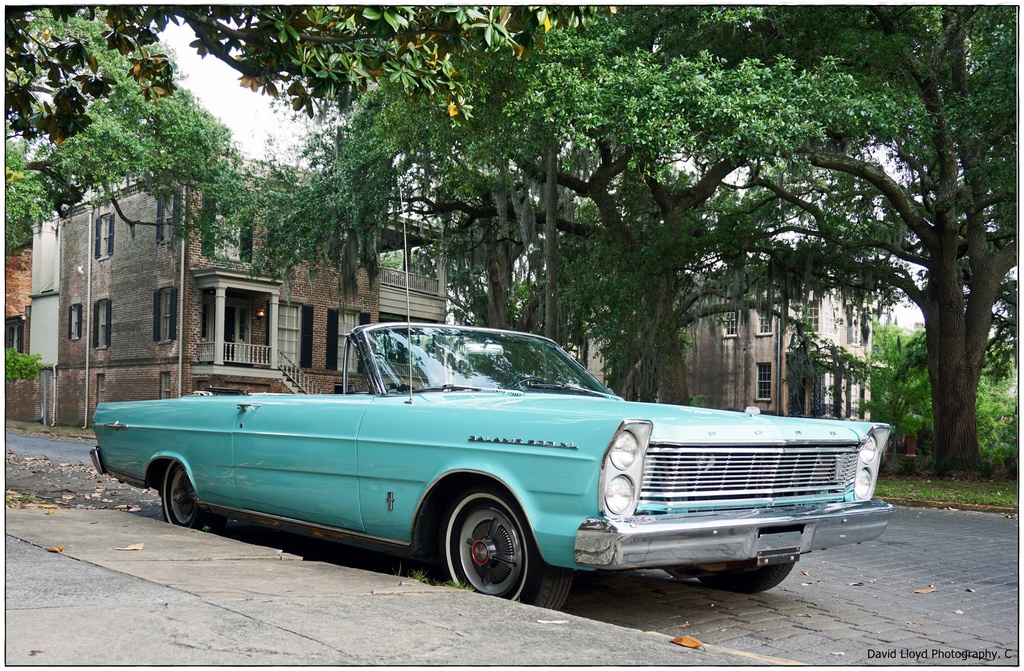
This Galaxie was shot with the A6000 16-50 kit lens on a Savannah street and I was very close to the front of the car, I was backed up to a wall. There's been some PP but no perspective correction. I don't think that's bad.
_________________
LENSES & CAMERAS FOR SALE.....
I have loads of stuff that I have to get rid of, if you see me commenting about something I have got and you want one, ask me.
My Flickr https://www.flickr.com/photos/mudplugga/
My ipernity -
http://www.ipernity.com/home/294337 |
|
| Back to top |
|
 |
|
|
